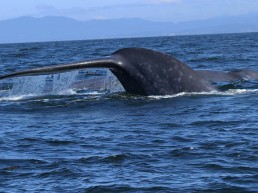Blue Whales
The blue whale is the largest mammal to have lived on earth. They reach lengths of 100 feet and can weigh as much as 150 tons. They have two large blowholes that have a raised shield in the front. The spouts are over 25 feet high. The blue whale is blue/gray in color with barnacles on their flukes and the tips of the flippers. The dorsal fin is only about one foot and is ¾ of the way back on the body.
Blue whales can cruise the oceans at 5-12 miles an hour. They can accelerate to more than 25 miles an hour when they are agitated. Blue whales are among the loudest animals on the planet. They emit a series of pulses, groans, and moans. It is thought that in good conditions blue whales can hear each other up to 1,000 miles away. Scientists think they use these vocalizations not only to communicate, but, with their excellent hearing, to navigate the ocean waters.
During the winter blue whales travel to the warm tropical waters to breed and give birth. During the summer they travel to the cooler polar waters to feed. Generally, the larger older whales migrate the furthest north during the migration. They eat virtually nothing for at least 4 months. Females give birth in warm tropical waters because the young only have a thin layer of blubber to keep them warm.
Blue whales are baleen whales which mean they have fringed plates of fingernail like material called a baleen attached to their upper jaws. Blue whales have about 250-400 fringed overlapping plates hanging from each side of the upper jaw. These plates are a finger like material called keratin and are about 20 inches long. When these whales are feeding large volumes of water and food are taken into the mouth. As their mouth closes water is expelled through the baleen plates. This traps the food inside where they then use their tongue to swallow the food.
These whales feed by gulping a mouthful of water expanding the pleated skin on their throat. Then they use their tongue to force the water out through the baleen plates. Blue whales feed mainly on small shrimp called krill. During the summer season the blue whale will consume about 4 tons of krill a day.
Blue whales reach sexual maturities between the ages of 6-10 years. The females have their calves every 2-3 years, and the gestation period is about 12 months. Calves are born 24 to 27 feet long and weigh 3 tons. They consume 100 gallons of fat rich mother’s milk every day and gain 200 pounds a day. The average lifespan for the blue whale is estimated around 80 to 90 years with some reaching over 100 years of age. It is thought that between 10,000 and 25,000 blue whales still swim the world’s oceans.

